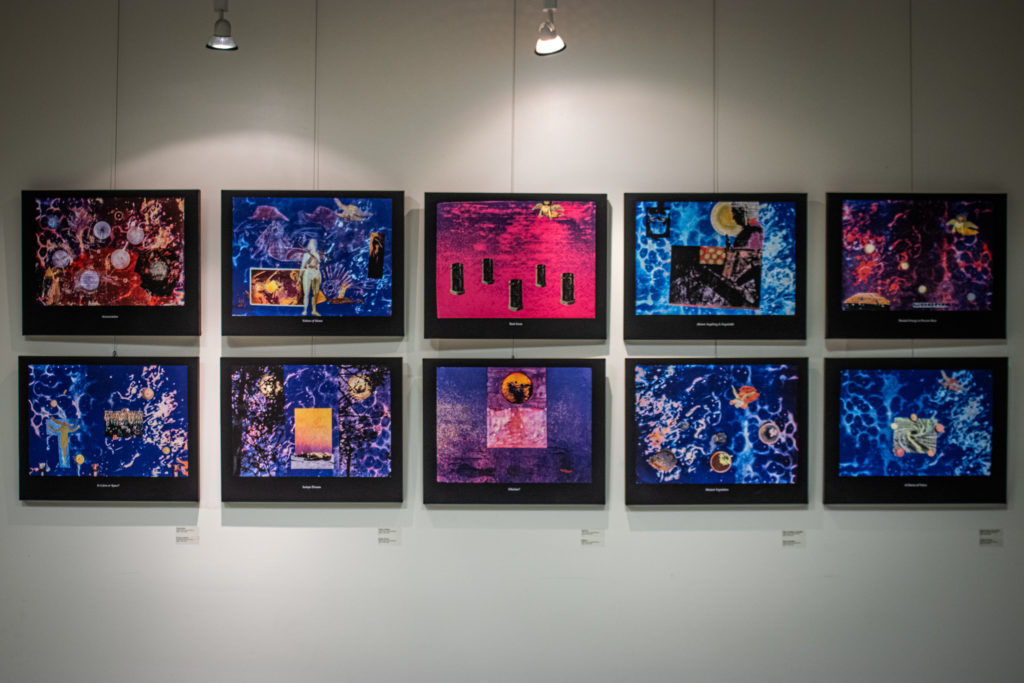Whether you are walking along campus trails, through the hallways of the Multimedia Classroom Building, along rows of books in the library or just wandered into the hallway outside of the cafeteria, art can be found in all the nooks and crannies of campus. From sculptures to paintings, different mediums capture the attention of students and staff. Printmaking and acrylic painting is currently displayed in the Dengerink Administration Building’s gallery and the Science and Engineering Building.
Printmaking uses woodcutting, engraving or etching a design into a certain material to use as a mould to transfer an image onto paper.

WSU Vancouver’s fine arts technician, Noah Matteucci, explained how printmaking can make each part of his images unique.
“I just fell in love with printmaking. There are century old techniques from wood cut all the way up to screen printing and I kind of fell in love with the mark that it made. Everything is being pushed through a press. So, it either prints or doesn’t, and it’s binary, it’s either a print or it’s not a print. … I kind of like the finality of it,” Matteucci said.

Matteucci said some of his art was inspired by images of random glitches when creating work on Adobe software.
“As I’m working in my studio, things by chance happen, random things happen. Sometimes my images glitch out and get corrupted. A lot of those times, those images were more interesting than the actual image I was making,” Matteucci explained.
Rita Robillard, former WSU Pullman professor, previously taught digital printmaking when there were no official printmaking classes offered at WSU Pullman. Robillard’s exhibition, featured in VDEN’s gallery, is titled, “Polarities and Votives.”
The exhibition is meant to serve as a contrast between tropical and polar worlds, according to Robillard. It includes select pieces from two of Robillard’s series: “Polarities: Patterns in Time” and “Votives for Hanford” (what to do with nuclear waste?), according to WSU Vancouver’s art on campus page.
One piece from the exhibition titled, “Luxuriant Vegetation” represents Hanford Site’s nuclear waste threat to the environment.

“In my statement I wrote something about duck-and-cover, which is an important part of history to know about. In the East Coast, from the time I was little, there would be drills. We had to duck under our desks because the bomb was coming from Russia, right? I think that’s an important part of my childhood that makes me attuned to this whole idea of nuclear warfare,” Robillard said.
Printmaking allows Robillard to lay the foundation for her pieces, with other mediums over top, such as painting, drawing, carving or sanding. She explained her desire for her work to reflect characteristics of the environment.
“I also almost want my work not to be reproducible. I want it to be tactile. You can tell with ‘Luxuriant Vegetation,’ it has a lot of layers and is very sculptural. There’s no way to really reproduce it. I think that’s also true for the environment,” Robillard said.

Katie Babb, senior fine arts major, worked with Robillard while setting up the VDEN exhibition. Babb expressed her admiration for Robillard’s art.
“I really appreciate her process and how she will come back to something to add something else. Some of what’s in her painting is like a mixture of collage and printmaking and then she paints on top of it and it’s just really layered.… I think to me personally, that’s relatable, just mixing different mediums together to create the thing that you wanted to make,” Babb said.
An artist herself, Babb encouraged young artists just starting out to not be discouraged.
“Don’t get discouraged by being a beginner or whatever stage you’re at. Practice a lot, that’s how you will get better. Look at other artist’s work and go to as many museums and galleries as you can,” Babb said.

Emily is a senior studying integrated strategic communication at WSU Vancouver.
